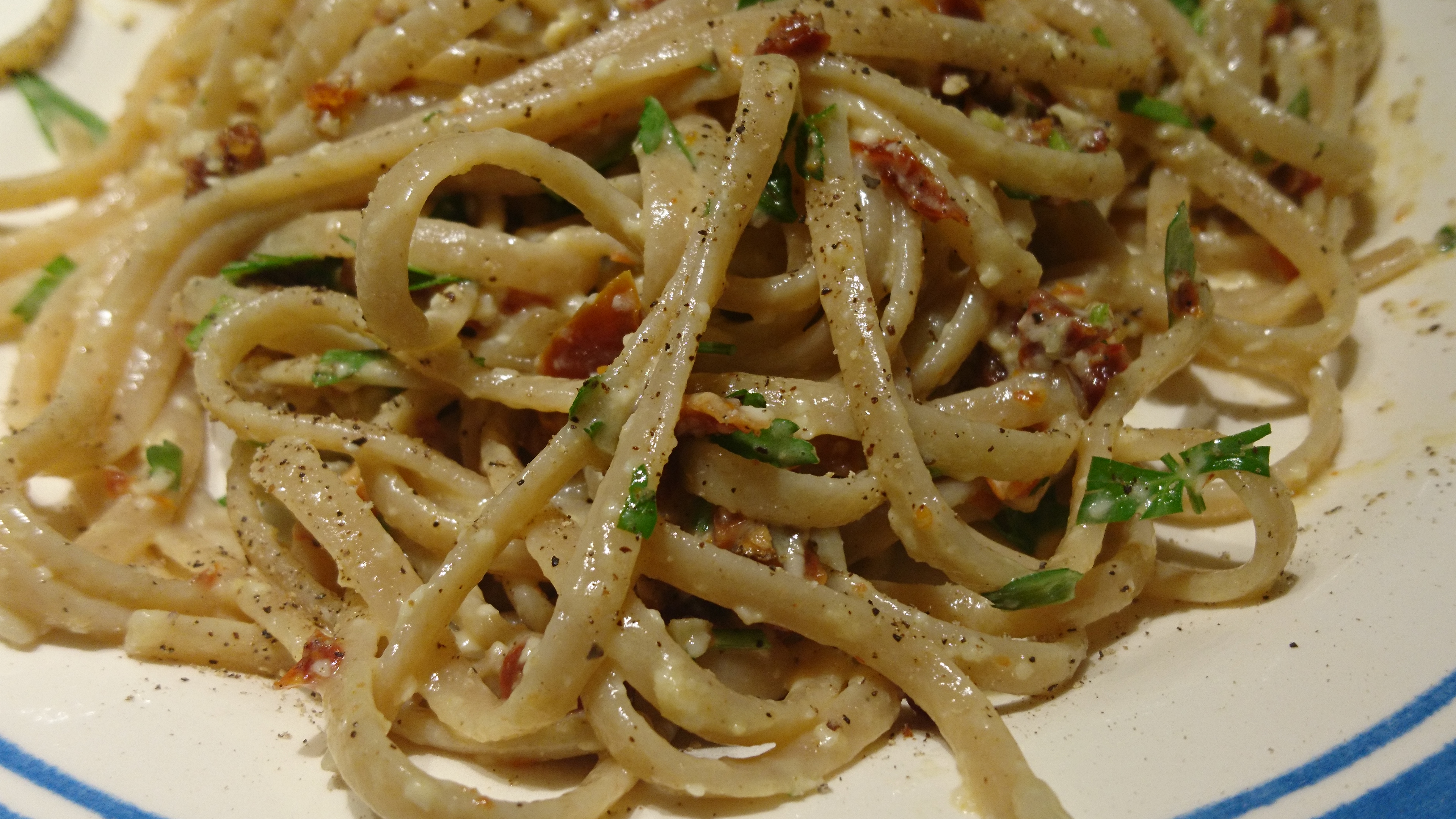pasta non carborundum
Here's a super-fast, tasty pasta recipe you may be able to make from ingredients you have in your pantry right now. Like other dishes I'm publishing for quarantine month, fresh ingredients in it are minimal. It's also a Good First Recipe.
The name of this dish comes from the mock-Latin aphorism "illegitimati non carborundum", which supposedly translates to "don't let the bastards grind you down" (this also appears in the Handmaid's Tale as "nolite te bastardes carborundorum"). It's an extra play on words, since the recipe started as a vegetarian variant of Pasta Carbonara that our family gradually modified to be more interesting. The sentiment is also perfect for the current world circumstances.
Like any of the many pasta dishes that depend on tossing hot pasta with eggs or dairy, the key to this dish is timing. You need to have the egg-and-cheese mixture beaten and waiting in a bowl, so that you can take the hot pasta directly from the boiling pot and drop it in the sauce, and then toss it immediately. Do not drain it in a colander in the sink. The elapsed time from the pasta being cooked to serving the dish should be less than two minutes.
If you master this, you can make dozens of easy pasta dishes, including Cacio e Pepe, alla Gricia, and Fettucine Alfredo. And, of course, traditional Spaghetti alla Carbonara. Since beaten-egg sauces are more forgiving than cheese, pork fat, or butter-and-cheese, I recommend starting with a recipe like this one.
So, some additional tips to help you in your mastery:
- Grab a salad tossing set, two big serving forks, or salad or BBQ "hands" to toss the pasta. While TV chefs are fond of using metal tongs, I've found that it's extremely hard to toss pasta effectively using them.
- You want a room-temperature, or slightly warm, bowl to toss the pasta with its sauce. If you toss it in the cooking pot, the sauce will overheat and become clumpy (this is the #1 cause of Cacio e Pepe failures). Ideally, this will be a large, heavy ceramic or glass bowl. To save dishes, this can/should be your serving bowl as well.
- Each of the "tossed" pasta recipes has its own recommended pasta to use, and there's reasons for that that have to do with flexibility and heat retention. Substituting pastas may result in the sauce failing, so if you have it available you should try to use the recommended pasta. In the case of Pasta Non Carborundum, I strongly recommend linguine, because you want a thicker pasta than spaghetti to retain enough heat to cook the sauce ingredients.
- Unless you have special equipment, these recipes scale up poorly. With too much pasta at once, the sauce will not emulsify. Instead of trying to make a quadruple batch for a crowd, set things up so that you can do multiple batches in a row.
pasta non carborundum
12oz linguine or similar
2 eggs, beaten
1/4 cup good olive oil
2-3 tbs lemon juice
1/2 cup finely grated pecorino romano, grana padano, or parmigiano cheese
2 oz sun-dried tomatoes, chopped or cut into slivers, around 3/4 cup
minced parsley, around 1/2 cup
salt "to taste" (see below)
fresh ground pepper, around 1/2 tsp
equipment: pasta pot, large heavy bowl, tossing forks, whisk, pasta strainer, tongs or fork
Heat up a 4qt or larger pot with well-salted water (1 tsp per liter of water), until it boils.
Beat the eggs with the olive oil and lemon juice in the large heavy bowl. Mix in the pepper, any salt, the cheese, and minced tomatoes and parsley. Set next to the stove.
In the boiling water, cook the pasta slightly past "al dente" according to the package instructions. For most linguine, this will be 10 to 11 minutes.
As soon as the pasta is done, grab it out of the pot and drop it in the bowl (or strain it, reserving some pasta water, and immediately dump it in before it cools). Toss the pasta with the sauce ingredients right away, scraping the bottom of the bowl to make sure that all ingredients are incorporated. If the pasta seems a little dry, add a little (1/4 to 1/2 cup) of pasta cooking water and toss again.
Serve immediately. Serves 2 as a main dish and 3-4 as a side dish. Do not save leftovers.
Notes on ingredients:
Dried Linguine is the ideal pasta for this dish, and it even works with whole wheat linguine. You can make it with spaghetti, but the thinner pasta requires faster, more determined tossing. It would probably work with fettucine or pappardelle too, but angel hair won't work, nor will short, "stubby" pastas like penne.
Cheese and Salt: if using pecorino romano, you'll want to add either no salt, or up to 1/4 tsp salt to the mix. If using parmigiano, you'll want a little more, maybe 1/2 to 3/4 tsp.
Parsley could be replaced with basil or cilantro, or even dried herbs (in which case use 2 tsp instead of the 1/2 cup).
